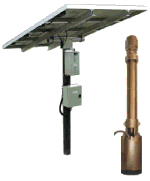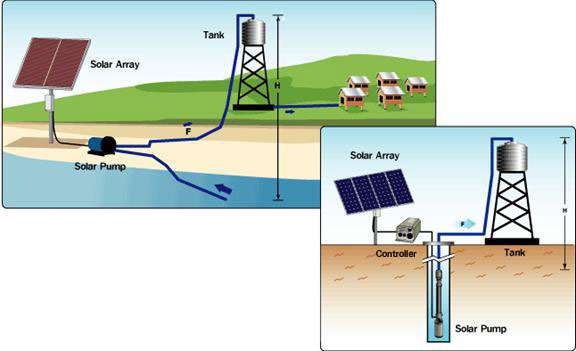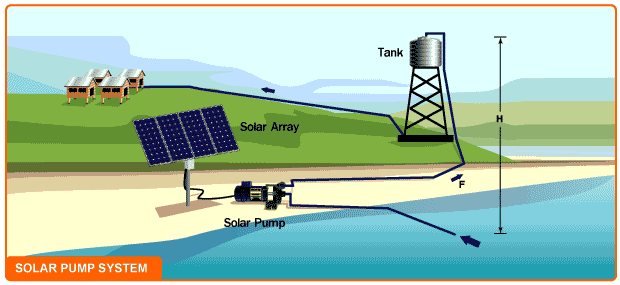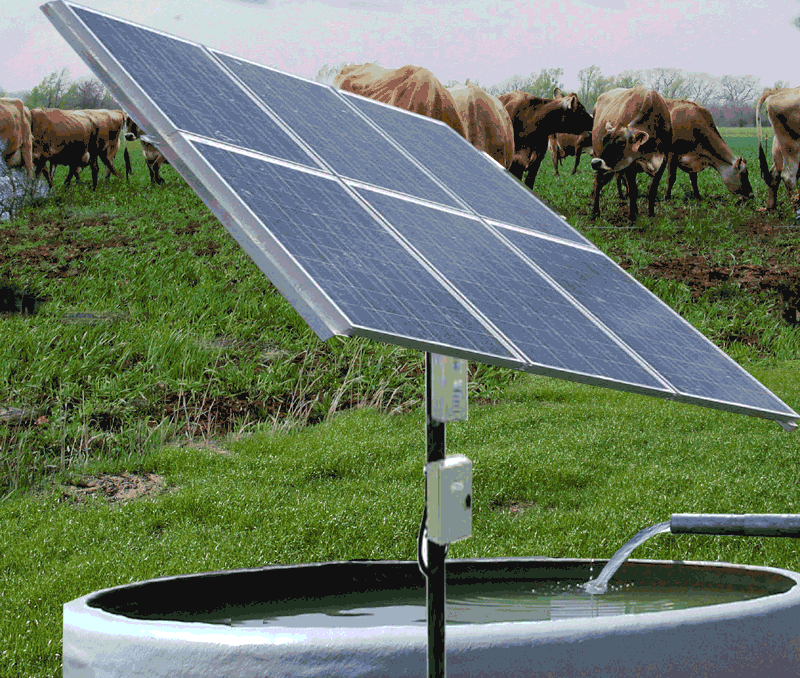|
|
|
 We Turn Sunlight Into Power
We Turn Sunlight Into PowerSolar water pumps are specially designed to lift water for irrigation, drinking and other similar applications. Solar technology is very well suited to pumping water. During the hot months, when water requirements are highest, a solar pump will provide a reliable water source for a farm.
There are two basic types of solar-powered water pumping systems, battery-coupled and direct-coupled. A variety of factors must be considered in determining the optimum system for a particular application.
Battery-Coupled Solar Pumping Systems
Battery-coupled water pumping systems consist of photovoltaic (PV) panels, charge control regulator, batteries, pump controller, pressure switch and tank and DC water pump. The electric current produced by PV panels during daylight hours charges the batteries, and the batteries in turn supply power to the pump anytime water is needed. The use of batteries spreads the pumping over a longer period of time by providing a steady operating voltage to the DC motor of the pump. Thus, during the night and low light periods, the system can still deliver a constant source of water for livestock.
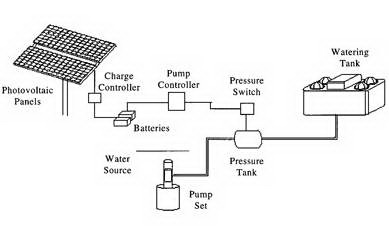
Battery-coupled solar water pumping system.
Direct-Coupled Solar Pumping System
In direct-coupled pumping systems, electricity from the PV modules is sent directly to the pump, which in turn pumps water through a pipe to where it is needed. This system is designed to pump water only during the day. The amount of water pumped is totally dependent on the amount of sunlight hitting the PV panels and the type of pump. Because the intensity of the sun and the angle at which it strikes the PV panel changes throughout the day, the amount of water pumped by this system also changes throughout the day. To compensate for these variable flow rates, a good match between the pump and PV module(s) is necessary to achieve efficient operation of the system. Direct-coupled pumping systems are sized to store extra water on sunny days so it is available on cloudy days and at night.
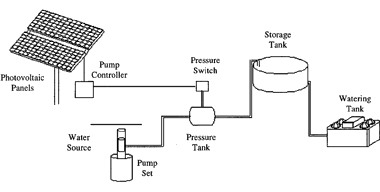
What kinds of Solar-Powered Pumps are commonly used?
Solar-powered pumps for livestock water supplies are available in a wide variety of configurations. If the water source is a dugout, floating pumps are available. If the water source is a well, submersible centrifugal pumps are often used. For dugouts, streams and shallow wells, self-priming surface centrifugal or positive-displacement pumps can be used. Whatever kind of pump is used, it is especially important in low-voltage applications like solar energy, that care is taken to ensure that the pump is matched to head and discharge requirements of the application.
How much Water can a Solar-Powered Pump Deliver?
Solar-powered pumping systems can be configured to meet a wide variety of demands. The amount of water a solar-powered pump can deliver is a function of how far the water has to be lifted, the distance it has to travel through a delivery pipe (and the size of pipe), the efficiency of the pump being used, and how much power is available to the system. Power can be increased by adding more solar panels. For example, a h.p. pump supplied by three 50-watt panels can deliver water at a rate of about 1½ gpm to a location 30 m higher than the source. As a comparison, a 3 h.p. low-lift irrigation pump powered by an array of 60 panels could deliver water at a rate of about 1,000 gpm.
How much does a Solar-Powered Pumping System Cost, and when as it Cost-Effective to use one?
Generally, if the water source is further than about a kilometer from a power line, it will be less expensive to use solar power rather than extending the power line. The cost of a solar-powered pumping system will naturally vary according to its capabilities, but the cost of most systems for stockwatering applications ranges between $2,000 and $6,000.
What is required to maintain a Solar-Powered Pumping System?
One of the main advantages of a solar-powered pumping system is its simplicity and durability. The pump is the only part of the system having any moving parts, and it comprises a relatively small portion of the total system cost. Unless the system is installed in an extremely dusty area, occasional inspection of the wiring and the general appearance of the panels will be all that is necessary. Panels can be cleaned with plain water and a soft cloth. The frequency of inspection should match the amount of storage available. For example, if the system incorporates a three-day supply of water and/or energy in storage, then it should be inspected at least every three days.
Batteries and electrical components should be housed in a vented, weather-proof enclosure. For late-season or winter use, the enclosure should be insulated. The solar panels and the battery enclosure should also be protected from damage that might be caused by cattle. Small solar pumping systems that incorporate two or three panels can be easily moved, which can be a major advantage for applications such as rotational grazing systems. The panels, battery-enclosure and a storage tank can all be mounted on a trailer or skid, and the pump and piping can be disconnected for transport.
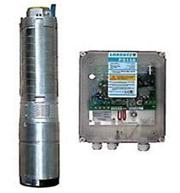 |
Solar Water Pump (model: kvcenterprises)
Applications include:
|
|
|
|
